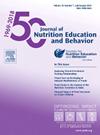快餐和传统餐饮连锁餐厅儿童菜单营养质量研究
IF 2.3
3区 医学
Q2 EDUCATION, SCIENTIFIC DISCIPLINES
引用次数: 0
摘要
在许多国家,在家庭以外消费的食物在总膳食摄入量中所占的比例越来越大。外出就餐往往会消耗更多的食物,摄入更多的能量,而营养摄入不足。许多餐馆提供儿童菜单;然而,这些食品往往缺乏健康的选择。哥斯达黎加连锁餐厅的儿童菜单的营养质量是未知的。目的对连锁餐厅儿童菜单所提供的食物进行特征分析,确定快餐与传统餐厅在营养质量上是否存在差异。研究设计,环境,参与者横断面研究设计,评估哥斯达黎加大都市区主要购物中心的连锁餐厅(n=74家独特的连锁餐厅)。可测量的结果/分析在调整和评估其观察者间的可靠性后,使用儿童菜单健康评分(KIMEHS)来确定儿童菜单的营养质量。确定了儿童菜单的存在,KIMHES的个人类别(存在/不存在)和总体KIMHES得分。采用Mann Whitney检验,根据KIMHES判定快餐与传统餐厅的营养质量是否存在差异,显著性为P <;0·05。结果41.9%的餐厅提供儿童菜单。根据KIMEHS, 96.8%的菜单被认为是不健康的。快餐和传统餐馆之间没有显著差异。最常见的主菜是鸡块(83.9%)、汉堡(54.8%)和意大利面(41.9%)。大多数餐厅(83.9%)将炸薯条作为配菜。只有6.4%的餐厅在菜单上提供水果。结论提供的儿童菜单营养质量较差,健康选择的种类和可用性有限。有必要制定政策和做法,促进儿童在外出就餐时选择营养质量更好的食物。FundingNone本文章由计算机程序翻译,如有差异,请以英文原文为准。
Nutrition Quality of Children’s Menus Offered by Fast-Food and Traditional-Food Chain Restaurants
Background
Foods consumed outside the home contribute to an increasing proportion of total dietary intake in many countries. Eating away from home has been associated with the consumption of larger portions, higher energy intakes, and inadequate nutrient intakes. Many restaurants offer children’s menus; however, these often lack healthy choices. The nutrition quality of children’s menus of chain restaurants in Costa Rica is unknown.
Objective
To characterize foods offered by children’s menus of chain restaurants and to determine whether differences exist in the nutrition quality between fast-food and traditional restaurants.
Study Design, Settings, Participants
Cross-sectional study design, assessing chain restaurants located in main shopping centers of the Greater Metropolitan Area of Costa Rica (n=74 unique chain restaurants).
Measurable Outcome/Analysis
After adapting and evaluating its inter-observer reliability, the Kids Menu Healthy Score (KIMEHS) was used to determine the nutritional quality of children’s menus. The presence of a children’s menus, KIMHES individual categories (presence/absence) and overall KIMHES score were determined. The Mann Whitney test was used to determine whether differences existed in the nutrition quality according to KIMHES between fast-food and traditional restaurant, at a significance of P < 0·05.
Results
Of all restaurants, 41.9% offered a children’s menu. According to KIMEHS, 96.8% of the menus were considered unhealthy. There were no significant differences between fast food and traditional restaurants. The most common main dishes were chicken nuggets (83.9%), hamburgers (54.8%) and pasta (41.9%). Most restaurants (83.9%) included French fries as a side dish. Only 6.4% offered fruit in their menus.
Conclusions
The children’s menus offered had poor nutritional quality, with limited variety and availability of healthy options. There is a need for policies and practices that promote better nutritional quality of food options for children when they eat outside the home.
Funding
None
求助全文
通过发布文献求助,成功后即可免费获取论文全文。
去求助
来源期刊
CiteScore
4.20
自引率
11.50%
发文量
379
审稿时长
44 days
期刊介绍:
The Journal of Nutrition Education and Behavior (JNEB), the official journal of the Society for Nutrition Education and Behavior, is a refereed, scientific periodical that serves as a global resource for all professionals with an interest in nutrition education; nutrition and physical activity behavior theories and intervention outcomes; complementary and alternative medicine related to nutrition behaviors; food environment; food, nutrition, and physical activity communication strategies including technology; nutrition-related economics; food safety education; and scholarship of learning related to these areas.
The purpose of JNEB is to document and disseminate original research and emerging issues and practices relevant to these areas worldwide. The Journal of Nutrition Education and Behavior welcomes evidence-based manuscripts that provide new insights and useful findings related to nutrition education research, practice and policy. The content areas of JNEB reflect the diverse interests in nutrition and physical activity related to public health, nutritional sciences, education, behavioral economics, family and consumer sciences, and eHealth, including the interests of community-based nutrition-practitioners. As the Society''s official journal, JNEB also includes policy statements, issue perspectives, position papers, and member communications.

 求助内容:
求助内容: 应助结果提醒方式:
应助结果提醒方式:


